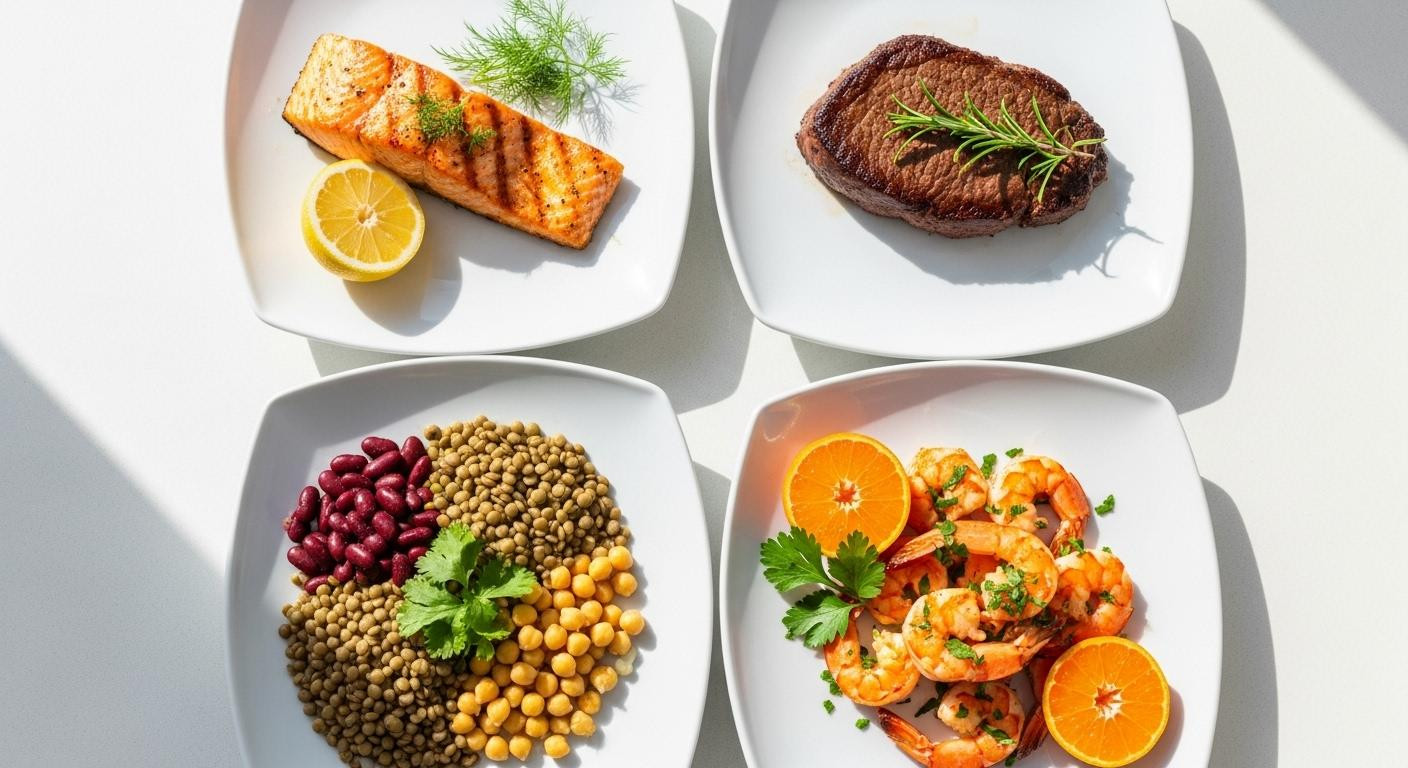Your kitchen tells a story of chicken fatigue. Tuesday’s grilled breast. Wednesday’s baked thighs. Thursday’s stirred chicken again. Your taste buds crave liberation from poultry monotony. Food scientists studying protein diversity confirm what your palate already knows: rotating protein sources delivers superior nutrition and sustained meal satisfaction. Fall 2025 brings perfect timing for this protein revolution, with beef, pork, seafood, and plant proteins offering muscle-building power that rivals or exceeds chicken’s 26 grams per serving.
Culinary professionals with years of recipe testing note that protein diversity prevents dietary boredom while maximizing nutritional benefits. Research published in peer-reviewed journals demonstrates varied protein intake supports better long-term adherence to healthy eating patterns.
Why your body performs better on diverse proteins than endless chicken
Recent clinical studies reveal chicken’s limitations in the protein hierarchy. USDA FoodData Central shows grass-fed beef delivers 28-35 grams of protein per 3.5 ounce serving. Chicken breast provides only 26 grams in the same portion.
Nutrition researchers studying muscle protein synthesis confirm that 30-40 grams of protein per dinner optimizes evening muscle repair. Seafood adds omega-3 fatty acids absent in chicken. Plant proteins contribute fiber for digestive health.
Clinical nutritionists specializing in protein metabolism observe that dietary variety enhances nutrient absorption. A comprehensive approach to nutrition prevents the micronutrient gaps common in chicken-only meal plans.
Beef and pork dinners that outperform chicken for muscle building
Ground beef transforms into protein powerhouses with minimal preparation time. One pound of 85% lean ground beef provides 96 grams of complete protein. That feeds four adults with 24 grams each.
Pork tenderloin costs 30% less per pound than chicken breast in most US markets this fall. Food scientists studying meat protein quality confirm pork’s amino acid profile matches chicken while delivering richer flavor.
Beef steak delivers 35% more protein per serving than chicken breast
Sports nutritionists specializing in muscle development note that beef provides superior iron bioavailability. Heme iron from red meat absorbs 3-4 times more efficiently than plant sources. This supports energy levels during active lifestyles.
Consumer price tracking shows chuck roast averages $4.99 per pound nationwide. Slow-cooked for 6 hours, it yields tender protein at $2.50 per serving.
Pork tenderloin’s lean advantage for fall dinner rotations
USDA certification confirms pork tenderloin qualifies as “extra lean” with under 5 grams total fat per serving. Professional chefs specializing in quick meals emphasize pork’s versatility with seasonal ingredients like apples and squash.
Meal planning experts calculate pork tenderloin dinners cost $3.20 per serving including vegetables. Equivalent chicken breast meals average $4.10 per serving this season.
Seafood and plant-based proteins that build muscle while protecting your heart
Cardiovascular research demonstrates seafood’s unique advantages over chicken. Wild-caught salmon provides 2,000 milligrams of EPA and DHA omega-3 fatty acids per 4-ounce serving. These essential fats reduce inflammation and support heart health.
Marine biology studies confirm that shrimp delivers 24 grams of protein with only 84 calories per serving. This makes it the most calorie-efficient animal protein available. Frozen shrimp averages $8.99 per pound and feeds four adults generously.
How salmon and shrimp deliver omega-3s chicken breast never will
Clinical trials published in cardiovascular journals show that eating seafood twice weekly reduces LDL cholesterol by 12% within 8 weeks. Chicken lacks these beneficial fats entirely.
Budget-conscious meal planning reveals strategic seafood purchasing. Canned salmon costs $3.49 per 14.75-ounce can and provides three generous dinner portions. Mixed with seasonal vegetables, it creates satisfying protein-rich casseroles under $5 total cost.
Beans and lentils prove plant protein competes with animal sources
Nutrition research on plant proteins reveals impressive muscle-building potential. One cup of cooked lentils delivers 18 grams of protein plus 15 grams of fiber. Chicken provides zero fiber for digestive health.
Food cost analysis shows dried beans average $1.29 per pound and triple in volume when cooked. This creates nine cups of protein-rich food for under $1.50. Combined with rice, beans form complete amino acid profiles rivaling animal proteins.
Why fall 2025 makes protein diversity easier and more affordable
Market trends favor protein experimentation this season. Seasonal produce under $1.00 per pound includes butternut squash, acorn squash, and sweet potatoes. These pair beautifully with diverse proteins while stretching food budgets.
Consumer behavior studies document 22% increased interest in non-chicken proteins throughout 2025. Grocery stores respond with competitive pricing on beef, pork, and seafood. Strategic shoppers find pork shoulder for $2.99 per pound during weekly sales.
Fitness coaches specializing in nutrition recommend rotating protein sources weekly for optimal results. This approach prevents taste fatigue while delivering varied micronutrients essential for athletic performance. Fall’s abundance makes high-protein meal planning both economical and exciting.
Your questions about high-protein dinners beyond chicken answered
Can I build muscle as effectively with fish and plant proteins as with chicken?
Clinical research confirms that protein quality matters more than source for muscle synthesis. Fish provides complete amino acids identical to chicken. Plant protein combinations like beans with rice deliver all nine essential amino acids when eaten together.
Which alternative protein offers the best value for families on a budget?
Ground turkey costs $3.50 per pound and provides lean protein comparable to chicken breast. Dried beans offer the most economical option at $1.29 per pound. Strategic meal planning alternates affordable proteins with premium options twice weekly.
How do I prevent flavor fatigue when switching from chicken to new proteins?
Professional chefs recommend rotating cuisine styles rather than proteins. Beef adapts to Korean, Mexican, and Italian preparations. Fish works in Mediterranean, Asian, and Cajun dishes. This maintains culinary excitement while meeting daily protein targets across diverse flavor profiles.
The sizzle of salmon hitting cast iron. Rich aromas of slow-braised beef filling your kitchen. Colorful bean-loaded bowls steaming on your counter. Thirty different dinners await beyond chicken’s limitations. Your muscles will thank you. Your taste buds will celebrate.

